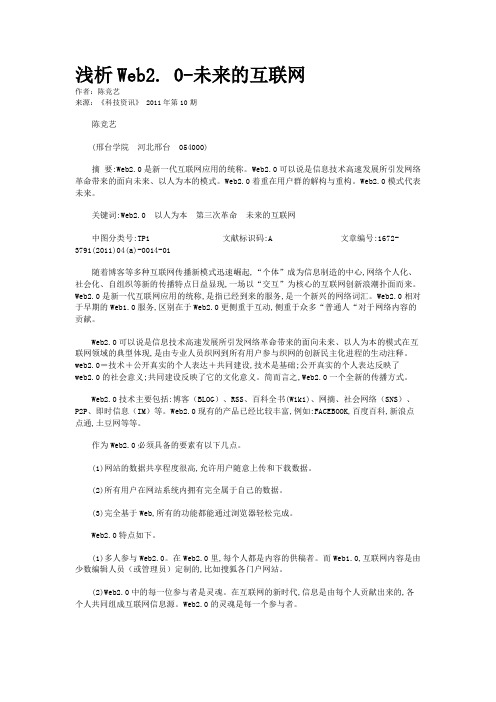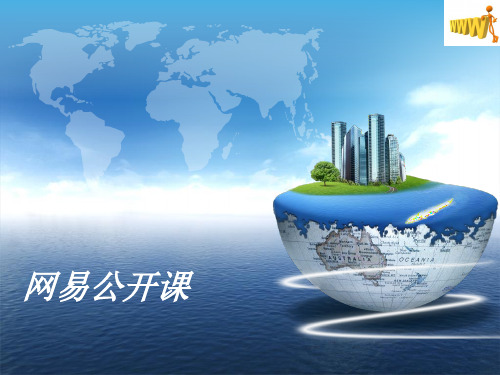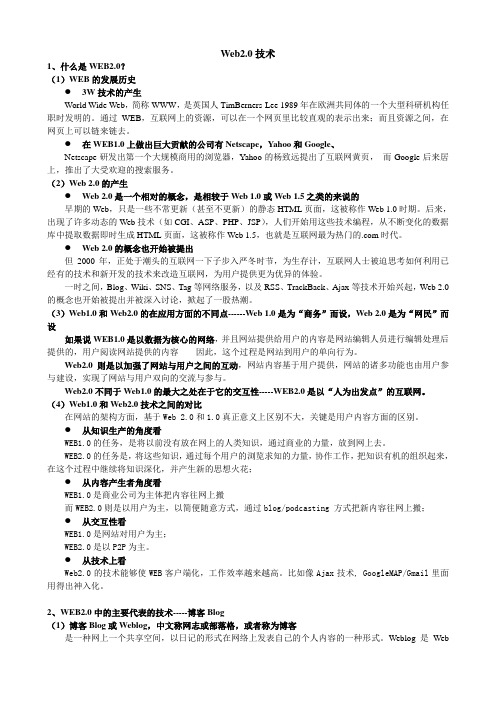蓝天白云:Web2.0与创新
- 格式:ppt
- 大小:550.00 KB
- 文档页数:18

web2.0是什么意思
Web2.0 是相对于Web1.0的新的时代。
指的是一个利用Web的平台,由用户主导而生成的内容互联网产品模式,为了区别传统由网站雇员主导生成的内容而定义为第二代互联网,web2.0是一个新的时代。
抛开纷繁芜杂的Web 2.0现象,进而将其放到科技发展与社会变革的大视野下来看,Web 2.0可以说是信息技术发展引发网络革命所带来的面向未来、以人为本的创新2.0模式在互联网领域的典型体现,是由专业人员织网到所有用户参与织网的创新民主化进程的生动注释。
Web2.0模式下的互联网应用具有以下显著特点:去中心化、开放、共享。
1、用户分享。
在Web2.0模式下,可以不受时间和地域的限制分享各种观点。
用户可以得到自己需要的信息也可以发布自己的观点。
2、信息聚合。
信息在网络上不断积累,不会丢失。
3、以兴趣为聚合点的社群。
在Web2.0模式下,聚集的是对某个或者某些问题感兴趣的群体,可以说,在无形中已经产生了细分市场。
4、开放的平台,活跃的用户。
平台对于用户来说是开放的,而且用户因为兴趣而保持比较高的忠诚度,他们会积
极地参与其中。

web2.0社区:产品和规则为王web2.0强调的用户主导、用户参与、用户参与、用户创造,从本质上说,web2.0大大提升了人与人之间的互动关系,那么只要有这种互动关系,这也就是社区,这是麦田曾经的经典分析。
web2.0网站其实就是社区。
不过现在web2.0网站强调用户贡献内容,却往往忽视用户价值所在,研究贡献驱动,去仅仅只按照一些表层的方式去执行,web2.0网站发展的起因是眼前一亮的UI,与众不同的服务,还算不错的用户体验,但是这只是让你有机会可能吸引到人的因素,但不是成功的决定性因素。
通过推广的营销战术,可以短时间吸引到人,但是留住人我认为需要2个根本性的条件:1.优质的产品:1.0时代你很难去评价产品如何,提供的更多的是信息,而web2.0完全不同,个性化、人性化、体验性等任何一种因素都有可能让一个网站脱颖而出,web2.0没有从根本上改变用户的需求,只是换了一种方式,更加关注他个体价值的方式满足他的需求,所以2.0时代,产品是可以评估的。
很多web2.0产品我认为不是好产品,满足了何种对于用户真正有价值的需求?我想更多人为了web2.0而web2.0。
好的产品其实就是最好的营销方式,用户帮你口碑相传,这是谁都希望看到的。
但是要给用户一个口碑相传的理由,做好产品是最务实的做法。
2.游戏规则:在产品因素问题不大的情况下,也许游戏规则决定了社区的长远发展。
一般性的游戏规则,可以提高一部分用户的积极性;优秀的游戏规则可以与商业模式紧密相连;没有游戏规则,很有可能就无序的发展,最终可能也没有了发展。
很遗憾现在不少web2.0网站希望用户贡献,但是用户凭什么贡献?没有这样一个机制,所有人都去做志愿者,在中国也许我们要等到共产主义阶段。
游戏规则,我很喜欢这样称呼,本身规则就具有一定的游戏性,最近一直在思考这个规则的问题,我认为有几点是非常重要的:规则一:网站的价值观应该算是潜规则,社区引到的方向,什么是好的,什么是不好的,从开始就在约束这件事情,web2.0时代经营者作的事情好比是搭舞台,演员就是用户,但是你要告诉演员什么剧目是这个舞台受欢迎的,当所有人按照这个价值观去做事情,就不会出现捣乱的人,出现了群众就把他赶下去。

浅析Web2. 0-未来的互联网作者:陈竞艺来源:《科技资讯》 2011年第10期陈竞艺(邢台学院河北邢台 054000)摘要:Web2.0是新一代互联网应用的统称。
Web2.0可以说是信息技术高速发展所引发网络革命带来的面向未来、以人为本的模式。
Web2.0着重在用户群的解构与重构。
Web2.0模式代表未来。
关键词:Web2.0 以人为本第三次革命未来的互联网中图分类号:TP1 文献标识码:A 文章编号:1672-3791(2011)04(a)-0014-01随着博客等多种互联网传播新模式迅速崛起,“个体”成为信息制造的中心,网络个人化、社会化、自组织等新的传播特点日益显现,一场以“交互”为核心的互联网创新浪潮扑面而来。
Web2.0是新一代互联网应用的统称,是指已经到来的服务,是一个新兴的网络词汇。
Web2.0相对于早期的Web1.0服务,区别在于Web2.0更侧重于互动,侧重于众多“普通人“对于网络内容的贡献。
Web2.0可以说是信息技术高速发展所引发网络革命带来的面向未来、以人为本的模式在互联网领域的典型体现,是由专业人员织网到所有用户参与织网的创新民主化进程的生动注释。
web2.0=技术+公开真实的个人表达+共同建设,技术是基础;公开真实的个人表达反映了web2.0的社会意义;共同建设反映了它的文化意义。
简而言之,Web2.0一个全新的传播方式。
Web2.0技术主要包括:博客(BLOG)、RSS、百科全书(Wiki)、网摘、社会网络(SNS)、P2P、即时信息(IM)等。
Web2.0现有的产品已经比较丰富,例如:FACEBOOK,百度百科,新浪点点通,土豆网等等。
作为Web2.0必须具备的要素有以下几点。
(1)网站的数据共享程度很高,允许用户随意上传和下载数据。
(2)所有用户在网站系统内拥有完全属于自己的数据。
(3)完全基于Web,所有的功能都能通过浏览器轻松完成。
Web2.0特点如下。


Web 2.0是什么Web 2.0,指的是一个利用Web的平台,由用户主导而生成的内容互联网产品模式,为了区别传统由网站雇员主导生成的内容而定义为web2.0。
接下来小编为大家整理网站应如何创建。
希望对你有帮助哦!The phrase Web 2.0 was created by O'Reilly Media to refer to a supposed second generation of network-centric services available on the internet that let people collaborate and share information online in a new way - such as social networking sites, wikis, communication tools and folksonomies. O'Reilly Media, in collaboration with MediaLive International, used the phrase as a title for a series of conferences and since then it has become a popular, if ill-defined and often criticized, buzzword amongst the technical and marketing communities.IntroductionWith its allusion to the version numbers that commonly designate software upgrades, the phrase "Web 2.0" trendily hints at an improved form of the World Wide Web, and the term has appeared in occasional use for several years. The more explicit synonym "Participatory Web", emphasizing tools and platforms that enable the user to tag, blog, comment, modify, augment, select from, rank, and generally talk back to the contributions of other users and the general world community has increasingly seen use as an alternative phrase. Some commentators regard reputation-based public wikis, like Wikipedia, as pioneering examples of Web 2.0/Participatory Web technology.O'Reilly Media and MediaLive International popularized the term Web 2.0 for a conference they hosted after Dale Dougherty mentioned it during a brainstorming session. Doughertysuggested that the Web was in a renaissance, with changing rules and evolving business models. The participants assembled examples — "DoubleClick was Web 1.0; Google AdSense is Web 2.0. Ofoto is Web 1.0; Flickr is Web 2.0" — rather than definitions. Dougherty recruited John Battelle for a business perspective, and it became the first Web 2.0 Conference in October 2004. A second annual conference was held in October 2005.In their first conference opening talk, O'Reilly and Battelle summarized key principles they believe characterize Web 2.0 applications: the Web as platform; data as the driving force; network effects created by an architecture of participation; innovation in assembly of systems and sites composed by pulling together features from distributed, independent developers (a kind of "open source" development); lightweight business models enabled by content and service syndication; the end of the software adoption cycle ("the perpetual beta"); software above the level of a single device, leveraging the power of The Long Tail.Earlier users of the phrase "Web 2.0" employed it as a synonym for "semantic web", and indeed, the two concepts complement each other. The combination of social networking systems such as FOAF and XFN with the development of tag-based folksonomies and delivered through blogs and wikis creates a natural basis for a semantic environment. Although the technologies and services that comprise Web 2.0 are less powerful than an internet in which the machines can understand and extract meaning, as proponents of the Semantic Web envision, Web 2.0 represents a step in its direction.As used by its proponents, the phrase refers to one or more of the following:The transition of websites from isolated information silos to sources of content and functionality, thus becoming computing platforms serving web applications to end usersA social phenomenon referring to an approach to creating and distributing Web content itself, characterized by open communication, decentralization of authority, freedom to share and re-use, and "the market as a conversation"A more organized and categorized content, with a far more developed deeplinking web architectureA shift in economic value of the web, possibly surpassing that of the dot com boom of the late 1990sA marketing term to differentiate new web businesses from those of the dot com boom, which due to the bust now seem discreditedThe resurgence of excitement around the possibilities of innovative web applications and services that gained a lot of momentum around mid 2005Many find it easiest to define Web 2.0 by associating it with companies or products that embody its principles and Tim O'Reilly gave examples in his description of his four plus one levels in the hierarchy of Web 2.0-ness:Level 3 applications, the most Wev 2.0, which could only exist on the internet, deriving their power from the human connections and network effects it makes possible and growing in effectiveness the more people use them. His examples were EBay, craigslist, Wikipedia, , Skype, Dodgeball, Adsense for Content, and Amazon.Level 2 applications, which can be offline but gain unique advantages from being online. His example was Flickr, benefiting from its shared photo database and community-generated tagdatabase.Level 1 applications are also available offline but gain features online. His examples were Writely, gaining group editing capability online and iTunes because of the music store portion.Level 0 applications would work as well offline. His examples were MapQuest, Yahoo! Local, and Google Maps. Mapping applications using contributions from users to advantage can be level 2.non-internet applications like email, IM clients and the telephone.Examples other than those cited by O'Reilly include digg, Shoutwire, last.fm, and Technorati.Commentators see many recently-developed concepts and technologies as contributing to Web 2.0, including weblogs, linklogs, wikis, podcasts, RSS feeds and other forms of many to many publishing; social software, web APIs, web standards, online web services, and others.Proponents of the Web 2.0 concept say that it differs from early web development (retrospectively labeled Web 1.0) in that it moves away from static websites, the use of search engines, and surfing from one website to the next, towards a more dynamic and interactive World Wide Web. Others argue that the original and fundamental concepts of the WWW are not actually being superseded. Skeptics argue that the term is little more than a buzzword, or that it means whatever its proponents want it to mean in order to convince their customers, investors and the media that they are creating something fundamentally new, rather than continuing to develop and use well-established technologies.The retrospectively-labeled "Web 1.0" often consisted ofstatic HTML pages, rarely (if ever) updated. They depended solely on HTML, which a new Internet user could learn fairly easily. The success of the dot-com era depended on a more dynamic Web (sometimes labeled Web 1.5) where content management systems served dynamic HTML web pages created on the fly from a content database that could more easily be changed. In both senses, so-called eyeballing was considered intrinsic to the Web experience, thus making page hits and visual aesthetics important factors.Proponents of the Web 2.0 approach believe that Web usage has started increasingly moving towards interaction and towards rudimentary social networks, which can serve content that exploits network effects with or without creating a visual, interactive web page. In one view, Web 2.0 sites act more as points of presence, or user-dependent web portals, than as traditional websites. They have become so advanced new internet users cannot create these websites, they are only users of web services, done by specialist professional experts.Access to consumer-generated content facilitated by Web 2.0 brings the web closer to Tim Berners-Lee's original concept of the web as a democratic, personal, and DIY medium of communication.Web 2.0是一个由O'Reilly Media创造的术语,它的应用可以让人了解目前万维网正在进行的一种改变——从一系列网站到一个成熟的为最终用户提供网络应用的服务平台。

Web2.0技术1、什么是WEB2.0?(1)WEB的发展历史●3W技术的产生World Wide Web,简称WWW,是英国人TimBerners-Lee 1989年在欧洲共同体的一个大型科研机构任职时发明的。
通过WEB,互联网上的资源,可以在一个网页里比较直观的表示出来;而且资源之间,在网页上可以链来链去。
●在WEB1.0上做出巨大贡献的公司有Netscape,Yahoo和Google、Netscape研发出第一个大规模商用的浏览器,Yahoo的杨致远提出了互联网黄页,而Google后来居上,推出了大受欢迎的搜索服务。
(2)Web 2.0的产生●Web 2.0是一个相对的概念,是相较于Web 1.0或Web 1.5之类的来说的早期的Web,只是一些不常更新(甚至不更新)的静态HTML页面,这被称作Web 1.0时期。
后来,出现了许多动态的Web技术(如CGI、ASP、PHP、JSP),人们开始用这些技术编程,从不断变化的数据库中提取数据即时生成HTML页面,这被称作Web 1.5,也就是互联网最为热门的.com时代。
●Web 2.0的概念也开始被提出但2000年,正处于潮头的互联网一下子步入严冬时节,为生存计,互联网人士被迫思考如何利用已经有的技术和新开发的技术来改造互联网,为用户提供更为优异的体验。
一时之间,Blog、Wiki、SNS、Tag等网络服务,以及RSS、TrackBack、Ajax等技术开始兴起,Web 2.0的概念也开始被提出并被深入讨论,掀起了一股热潮。
(3)Web1.0和Web2.0的在应用方面的不同点------Web 1.0是为“商务”而设,Web 2.0是为“网民”而设如果说WEB1.0是以数据为核心的网络,并且网站提供给用户的内容是网站编辑人员进行编辑处理后提供的,用户阅读网站提供的内容------因此,这个过程是网站到用户的单向行为。
Web2.0则是以加强了网站与用户之间的互动,网站内容基于用户提供,网站的诸多功能也由用户参与建设,实现了网站与用户双向的交流与参与。
web2.0的优势及发展前景摘要:现在的互联网是一个单向的互联网,Web 2.0正在将互联网改造成为以人为中心的多向的互联网,网络反过来也在改变我们的工作和生活方式,也许将来SOHO将成为主要的工作方式。
Web 2.0带来的冲击将不会仅仅局限于互联网或者媒体,它对我们的影响也许比你想象的还要大几乎都将受到了这股趋势的强烈冲击,并且即将发生翻天覆地的变化。
关键字:web1.0;web2.0;互联网;播客;.AJAX;.API;IPTV;移动商务;网站小型化;无线应用。
0 引言Web起源]World Wide Web,简称WWW,是英国人TimBerners-Lee 1989年在欧洲共同体的一个大型科研机构任职时发明的。
通过WEB,互联网上的资源,可以在一个网页里比较直观的表示出来;而且资源之间,在网页上可以链来链去。
[Web1.0]在WEB1.0上做出巨大贡献的公司有Netscape,Yahoo和Google。
Netscape研发出第一个大规模商用的浏览器,Yahoo的杨致远提出了互联网黄页,而Google后来居上,推出了大受欢迎的搜索服务。
搜索最大的贡献是,把互联网上海量的信息,用机器初步分了个线索。
[语义网络]Tim-Berners-Lee在提出WWW不久,即开始推崇语义网(Semantic Web)的概念。
为什么呢?因为互联网上的内容,机器不能理解。
他的理想是,网页制作时和架构数据库时,大家都用一种语义的方式,将网页里的内容表述成机器可以理解的格式。
[Web2.0]WEB2.0是以人为核心线索的网。
提供更方便用户织网的工具,鼓励提供内容。
根据用户在互联网上留下的痕迹,组织浏览的线索,提供相关的服务,给用户创造新的价值,给整个互联网产生新的价值。
1、Web 2.0真的会改变了互联网吗?经过10年发展后,人们通过互联网已经可以完成比之前多得多的工作,得到更丰富、更精确、更迅捷的反馈,以及更加美妙的体验。
什么是web2.0?如今,Google、雅虎或者Microsoft等公司⼏乎每周都会宣布或推出新的⽹络服务。
渐渐地,隐藏在这些服务后⾯的互联⽹新轮廓显现出来,那就是Web 2.0。
可是,等待我们的究竟是什么呢?你可以把互联⽹想像成:⼀个⼈坐在⼀台功能有限的个⼈电脑前。
在⼤部分情况下,这些电脑使⽤的都是微软的Windows操作系统。
然后,电脑上加了⼀根传输数据的线,线的另⼀端,就是⼀个名为互联⽹的巨⼤的数据库。
但在Forrester Research公司的分析师查伦?李(Charlene Li)眼⾥,互联⽹却是另外⼀个样⼦:每⼀个⽹民拥有的其实不是⼀台⼩电脑,⽽是⼀个运算能⼒和存储容量都⽆⽐巨⼤的计算机。
这是她在最近在旧⾦⼭举⾏的“第⼆届Web 2.0⼤会”上提出的观点。
视⾓不同,说法不同。
如O'Reilly专业出版社⽼板Tim O'Reilly就是以操作系统来评定的。
在他眼⾥,只有Linux⽤户,每⼀个上⽹浏览的⼈,都依赖这个开放式系统,因为Google和雅虎这两个最⼤的互联⽹搜索引擎都是利⽤Linux系统来控制他们的天下的。
在Tim O'Reilly看来,与Linux相⽐,Windows的作⽤⼏乎不算什么:和我们通过宽带得到的⽹络功能相⽐,个⼈电脑充其量也就是⼀个带⿏标的显⽰器⽽已。
读者⼀同编写在查伦?李和O'Reilly看来,不仅是互联⽹等同于数据库的概念早已过时,⽤于有了博客(⽹络⽇志)、维基、公共书签等的问世,创造信息者和消费信息者之间已经不存在什么界限了。
假如把互联⽹⽐作图书馆的话,那就是每⼀个读者都可以参与创作,也就是不仅是全民上⽹,⽽且是全民织⽹。
这⼀切,并不是在⼀夜之间就形成的,因此,对推⼴Web 2.0这个概念发挥了关键作⽤的O'Reilly在⼀篇⽂章中说,这是互联⽹的演变,⽽不是⾰命。
但这⼀演变过程的欣欣活⼒现在也开始令开发互联⽹的⿐祖们坐不安宁了。
web 2.0(完整版)? (转载并略修改的doubleleaf翻译版Tim O’Reilly文章)摘要:看到doubleleaf翻译的Tim O’Reilly的web 2.0的文章,原文写的非常好,翻译的也很好,转载过来,并对部分本人认为可以修改的部分略作了修改。
修改内容用背景色标注了。
原文:/pub/a/oreilly/tim/news/2005/09/30/what-is-w eb-20.html?page=2原翻译:/index.php/2005/10/03/379什么是web 2.0为下一代软件的设计模式和商业模板2001年秋季网络泡沫的破灭标志着互联网的一个转折点。
很多人得出结论说,互联网被过分夸大了,实际上,泡沫和随之而来的衰退看上去是所有科技革命的共同特点。
衰退是正处于上升期的科技准备占据中央舞台的特色。
伪装者被逐出门外,真正的成名故事显示出他们的实力,开始理解一个事物与其他分开的原因。
Web 2.0的概念开始于O’Reilly与 MediaLive International的一个献计献策会。
网络先锋人物和O’Reilly公司副总裁Dale Dougherty指出,网络非但没有破灭,而且随着许多令人激动的新程序和网站让人惊讶的突然规律性出现,网络比以往的作用更重要。
更重要的是,在互联网灾难中幸存下来的公司看上去有一些共同的特点。
.com公司的垮掉能在某种程度上标志互联网的转折点吗, web 2.0这样的称呼有意义吗?我们同意它的确是,web 2.0大会就这样诞生了。
在那以后的一年半时间内,web 2.0这个词就无疑已经生根,在Google上有超过950万个引用结果。
但仍有大量对web 2.0含义的不同观点,一些人谴责这只不过是一个毫无意义的市场时髦炒作词汇(buzzword),其他人则认为它是一个新的传统概念。
web2.0想要表达的含义。
在最初的集体讨论上,我们用例子阐明了我们对web2.0的理解。
搞软件开发互联网策划人员经常会谈论Web2.0的话题,虽然说Web2.0已经出来很久了,那么Web2.0到底是什么呢?其实Web2.0代表了一个新的网络阶段,或者说是互联网建设的一种新的模式,它本身并没有特别的标准来进行描述,一般我们将促成这个阶段的各种技术和相关的产品服务统称为web2.0,这一新概念带动了技术和社会的新变革,例如BLOG的热潮。
Web2.0与Web1.0的比较:Web2.0是相对Web1.0的新的一类互联网应用的统称。
由Web1.0单纯通过网络浏览器浏览html网页模式向内容更丰富、联系性更强、工具性更强的Web2.0互联网模式的发展已经成为互联网新的发展趋势。
Web1.0的主要特点在于用户通过浏览器获取信息,web2.0则更注重用户的交互作用,用户既是网站内容的消费者(浏览者),也是网站内容的制造者。
Web1.0到Web2.0的转变,具体的说,从模式上是单纯的由“读”向“写”、“共同建设”发展。
所以互联网下一步,是要让所有的人都忙起来,用全民力量共同织出贴近生活的网。
到目前为止,对于web2.0概念的说明,通常采用 web2.0典型应用案例介绍,加上对部分Web2.0相关技术的解释。
下面从知识生产、内容生产、交互性和技术等角度比较两者的区别:从知识生产的角度看,Web1.0的任务,是将以前没有放在网上的人类知识,通过商业的力量,放到网上去。
Web2.0的任务是,将这些知识,通过每个用户的浏览求知的力量,协作工作,把知识有机的组织起来,在这个过程中继续将知识深化,并产生新的思想火花;从内容产生的角度看,Web1.0是商业公司为主体把内容往网上搬,而WEB2.0则是以用户为主,以简便随意方式,通过blog/podcasting方式把新内容往网上搬;从交互性看,Web1.0是网站对用户为主;Web2.0是以P2P为主;从技术上看,Web客户端化,出现富客户端模式,比如GoogleMAP/Gmail技术。